Contributed commentary by Tom Shannon, CEO, BatteryDAQ Monitoring Solutions
After 12 years without a major hurricane landing on the US mainland, two significant storms have severely damaged Houston and nearly the entire state of Florida in recent weeks. However, when we examine the impact they had on cell tower outages, they tell very different stories.
How so? Picture yourself in a telecommunications class room. The professor is at the front of the room and asks the straightforward question to the very intelligent students: “What was the cause for cell tower outages during Hurricane Harvey and Hurricane Irma?” Hands shoot skyward and the first student called on answers “Flooding. Severe flooding. Harvey resulted in flooding like has never been seen before. Five feet of rain.” The professor immediately responds, “Wrong.” and chooses the next eager student.
“Wind. Heavy winds. Irma landed with winds in excess of 140 miles per hour, and traveled the whole length of Florida.” The professor again replies quickly, “Wrong.”
After a few long seconds of stumped silence, the professor decides to tell the answer. Just then Johnny, in the back of the class, states “The power went out.” “Bingo!”, exclaims the professor. Johnny got an A.
Although Hurricane Harvey did produce an incredible amount of rain and unbelievable levels of flooding, the power in Houston stayed on, for the most part. As a result, very few cell towers went down, because the grid stayed up. However, Irma caused utility power to go off across huge areas of the state, resulting in the loss of power to approximately 7 million.
What did that do to the cell tower performance and wireless service? Here are some quotes from media articles:
In Miami-Dade and Broward counties, about 30 percent of all sites remain non-functioning — a decrease from 40 percent on Tuesday, the report said. – Miami Herald 9/11/2017
“According to the latest Federal Communications Commission’s status report released Wednesday, 64 percent of the county’s cell sites are out. Only Monroe and Hendry Counties have a higher outage percentage at 82 and 76 percent, respectively.” – Naples Daily News 9/12/2017
Statewide, 3,973 of 14,502 cell towers — 27 percent — were down at the exact time consumers were relying on them most.” – Sun Sentinel 9/15/2017
Now, you may think the general public’s response to all this media coverage may well be, “What do you expect? A massive hurricane went through the state of Florida, of course they are going to have outages. But, they worked hard to get them back up and are spending huge amounts of time and money making trip, after trip, after trip, out to the expensive generators to keep them filled with fuel.”
Again, you may think that is what the public’s opinion would be, but as the professor would say…”Wrong.”
Here is what a member of the general public had to say: ““We are in the dark and we are a society that depends on the Internet,” Sanchez said on Wednesday. Hundreds — perhaps thousands — of South Floridians seem to agree, according to social media and calls and emails to the Miami Herald. Outages on Comcast Xfinity, AT&T U-verse and Atlantic Broadband are widespread. On top of that, customers of cellular carriers Verizon, AT&T, Sprint and T-Mobile are also experiencing service disruptions. Sens. Rubio and Nelson sent a letter to FEMA Tuesday requesting they coordinate with relevant federal, state and local officials to help communications providers restore Florida’s networks.” – Miami Herald 9/13/2017
It is a certainty that almost all of our direct communication with one another depends on connectivity. In life or death situations, it is becoming imperative that cell towers and wireless service stay up. We are addicted to wireless technology, and we literally cannot live without it.
Remember what cell phone functionality was 10 years ago? Tablets? Streaming? Some of these examples weren’t even around, and if they were, they are now archaic. Face it, we are hooked, even if we don’t want to be.
In a time when society critically relies on wireless technology, carriers’ backup power reliability is nowhere near where it must be. But, there is an affordable and effective solution to greatly improve it. I submit that if the carriers were properly prepared for power outages, the vast majority of sites would have continued to work when the lights went out. It means that the cell site structures themselves held up well in the hurricane because they came back online when the backup power began to work. However, the evidence suggests the first line of backup power, battery strings, either did not work well, or failed outright, completely severing all means of communication.
As Hurricane Harvey told us, even with severe flooding, if the grid stays up, so do the cell sites. In contrast, Hurricane Irma also told us that once the utility power goes dark, cell sites struggle to remain up.
Today, there is no reason every carrier shouldn’t be prepared and confident that their backup battery power will work when needed, as needed. Just as wireless technology continues to improve and becomes more and more indispensable to how we function in society, so too does continuous state-of-health monitoring for remote cell sites.
To highlight the point, let’s switch from the classroom example to a telecom carrier conference room. The room is full of very intelligent peers. The Operations Director asks the straightforward question, “What could we have done better during Harvey and Irma, and how can we do better during future events?”
The first engineer answers “Nothing. It’s been twelve years since hurricanes like those hit the US. Even when they did, we recovered quickly. Sure it was expensive, but when you average the cost out over 12 years, it isn’t too bad.” The Ops Director immediately answers “Wrong.”, and recognizes the next engineer.
“On the front end, we could have prioritized the most important sites and left the lesser sites until the grid was restored. For the future, we can increase the number of manual battery measurements and generator maintenance visits. We make them mandatory and make every technician go through an internal certification program that they must pass within a certain time frame, or risk their bonuses, if not their job.” The Ops Director again replies “Wrong.”
After a prolonged silence, the Ops Director decides to share the answer. Just then Johnny, in the back of the conference room, states, “There are continuous battery monitoring solutions that are designed specifically for remote cell sites. The monitors are compact, well made, easy to install, and affordable. Their soft-”
“Affordable? How affordable?” questions the first engineer.
“The case can be made that for our most common battery configuration, the system will cost a fraction of the battery strings, have and ROI of 18 months, and last for over 10 years,” explained Johnny.
“How are we supposed to handle all of that data from tens of thousands of sites?” interjected the second engineer.
Johnny continued. “The software can manage from 1 to 1 million sites, either inside our firewall, or on a cloud-based server. We can scale up as we implement, eventually seeing all of our sites on a color-coded state-of-health display using Geo-Map reporting functionality. From there, we can rank our core sites, and prioritize the sites in most need of help using interactive criteria. We can also make well informed budgeting decisions using available dollars, or health rankings.”
“Bingo!” exclaims the Ops Director. Johnny got a promotion.
The fact is, there are now remote battery monitoring solutions that are built around the vision of providing field-proven technology, while overcoming budgetary concerns. It is too important for cell sites stay up, when the grid goes down. It is really that simple, and necessary.
Disclaimer: This blog is in no way meant to diminish the concern for every living creature in the paths of these natural disasters. I would also like to note that there exist many other ways to disrupt the power grid, both naturally and man-initiated. It is my hope that the effective protections against these types of events continues to improve.
Tom Shannon is the CEO of BatteryDAQ Monitoring Solutions in Hunt Valley, MD. He can be contacted at tom.shannon@batterydaq.com










